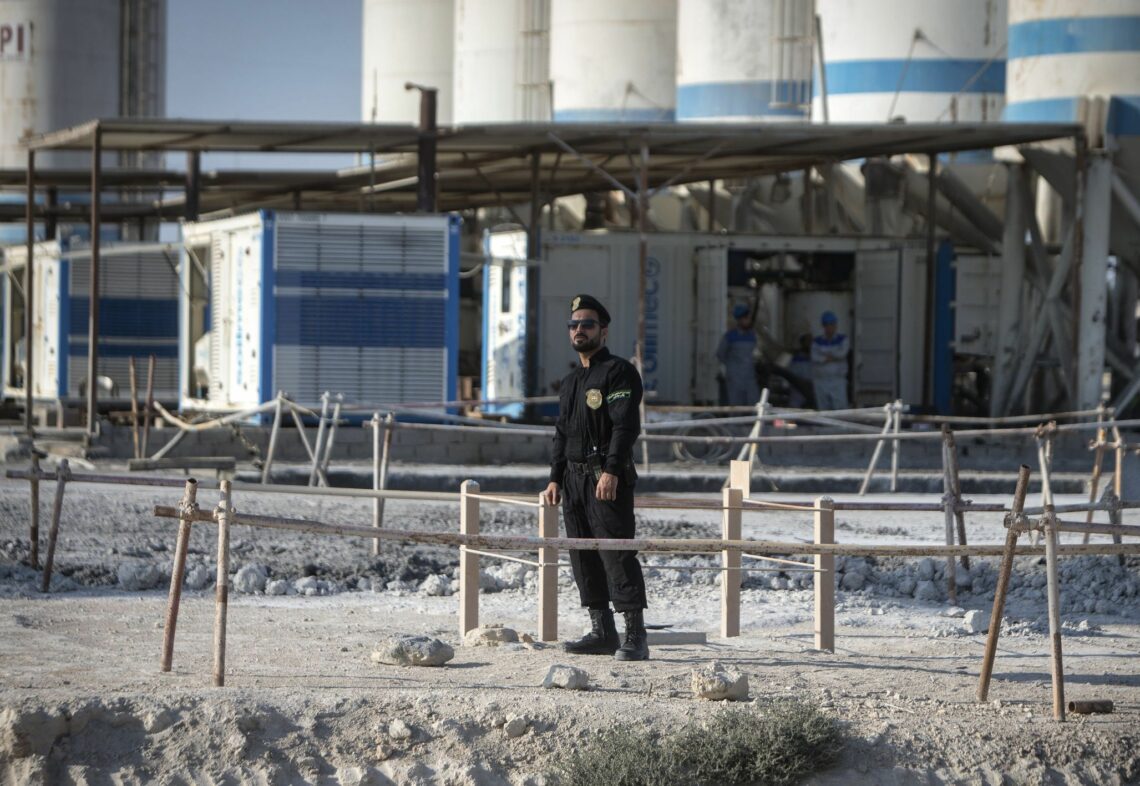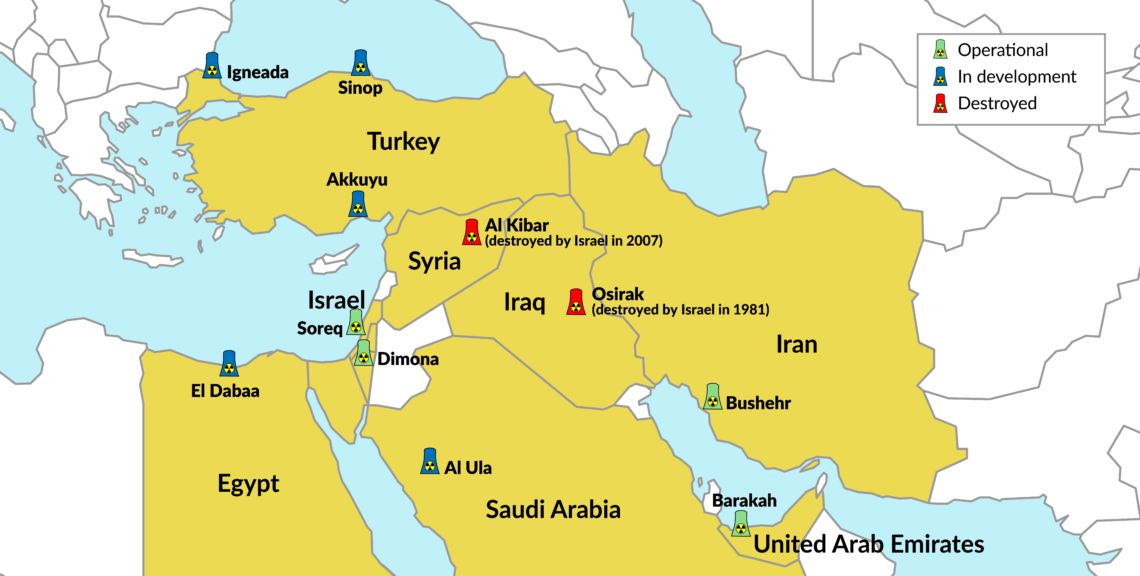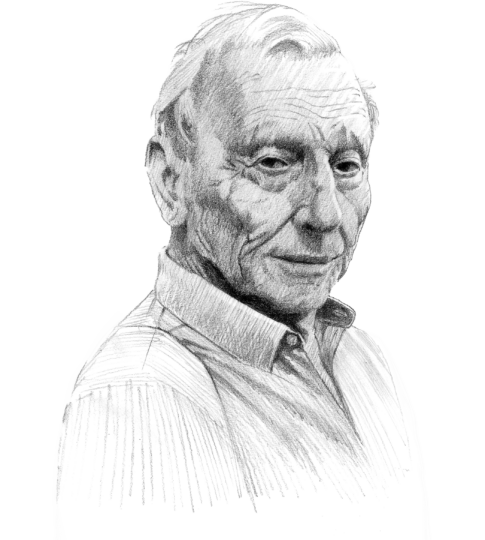A new push for nuclear power in the Middle East
The start-up of a new reactor in the United Arab Emirates has trained the spotlight on nuclear power in the Middle East. Outside of Iran’s controversial program, Saudi Arabia’s budding nuclear ambitions could prove the most destabilizing in the region.

In a nutshell
- Throughout the Middle East, nuclear power projects are moving ahead
- Most are under strict supervision; weapons programs are rare
- Saudi Arabia’s project remains a source of uncertainty
In early August, the first of four reactors at the Barakah nuclear power plant in the United Arab Emirates became operational. Until now, the world had paid little attention to efforts in the Middle East to harness nuclear power for peaceful or military purposes.
Situated in Abu Dhabi, the plant was established with the help of a consortium led by Korea Electric Power Corporation (KEPCO) and is the first commercial nuclear power station in an Arab country. It complies with International Atomic Energy Agency (IAEA) rules, including those regarding the enrichment and reprocessing of uranium. The Emirates established the Federal Authority for Nuclear Regulation to police such issues in 2009.
The Emirates is also a signatory to the Treaty on the Non-Proliferation of Nuclear Weapons (NPT) and its annexes, including the Additional Protocol allowing for extensive verification powers and unannounced on-site inspections. It was also one of the few countries to sign a so-called “123 agreement” with the United States for peaceful civilian atomic energy cooperation, allowing nuclear technology transfer. So far, Morocco, Egypt and Turkey have been granted that privilege, but not Saudi Arabia, a close ally of the U.S.
Facts & figures

The limitations that the Emirates has accepted demonstrate how dangerous the development of atomic energy could be if it bypasses the IAEA or flouts the NPT. (Iran’s nuclear program is a case in point.) Several Arab countries have unstable regimes or are embroiled in domestic conflicts. Nevertheless, these countries started to consider introducing atomic energy for civilian use at the start of the 21st century, though most of them have enough oil and gas reserves to produce electricity for many years to come. Atomic energy is a status symbol and a way to diversify economic resources. It can be used for agriculture and desalination and for medicine. By reducing local consumption of hydrocarbons, it also leaves more oil and gas for export.
Atomic energy is a status symbol and a way to diversify economic resources.
This is why the six members of the Gulf Cooperation Council – Saudi Arabia, the UAE, Qatar, Bahrain, Oman and Kuwait – commissioned a study of civilian uses of atomic energy in 2006 and a year later signed an agreement with the IAEA for a feasibility study regarding desalination. Some Arab states then reached cooperation agreements with several countries in the field of atomic energy or commissioned feasibility studies regarding building reactors. In most cases, nothing came of these agreements, either because there was no real need or because the country in question lacked the finances to carry out such a project.
Of course, before these events, some countries in the Middle East had developed nuclear power capabilities – but not for peaceful purposes.
Iraq
In the 1970s, Iraq – a signatory to the NPT – began secretly implementing a program to produce nuclear weapons. In 1976, France agreed to sell it an atomic reactor to be used for scientific research. Named Osirak, it was to operate with weapons-grade uranium. At the time, Iraqi President Saddam Hussein frequently threatened to destroy the state of Israel. On June 7, 1981, Israeli warplanes bombed the reactor and destroyed it shortly before it was due to become operational.
Libya
In the 1980s, Libya also decided to embark on a secret project to produce nuclear weapons. Muammar Qaddafi purchased thousands of centrifuges to enrich uranium on an atomic technology black market established by Abdul Qadeer Khan, a Pakistani nuclear scientist widely considered the father of his country’s nuclear weapons program. The plot was discovered by the U.S. and intense pressure was brought to bear on Qaddafi. In 2003, the Libyan leader announced he was ending the program and foreign inspectors would be allowed to examine the sites.
In 2006, France agreed to help Libya develop nuclear energy for civilian use. In 2007, the two countries signed a memorandum of understanding that indicated nuclear technology firm Areva would help Libya develop a reactor for desalination purposes. The fall of Qaddafi and subsequent civil war put an end to all these projects.
Syria
Though Syria also was a signatory of the NPT, it built, with the help of North Korea, a nuclear reactor that produced plutonium exclusively for military purposes. Again, it was clear that Israel was a potential target. Israeli warplanes destroyed the facility on November 7, 2007, as it was about to start production.
Israel
Israel has declared that it will not join the NPT until it signs peace agreements with countries that currently refuse to acknowledge its existence or threaten to destroy it. It does cooperate with the IAEA, of which it is a founding member and is represented by an ambassador in its institutions. Israel has conducted multiple joint projects to implement nuclear technology in various fields. Hundreds of Israeli researchers and experts take part in the organization’s assistance programs in developing countries.
The country has signed several additional nuclear safety agreements. The 5-megawatt nuclear Soreq nuclear research center, south of Tel Aviv, operates under the safeguards of the IAEA, whose experts inspect the facility twice a year.
Israel also has a 70-megawatt heavy-water nuclear reactor in the Dimona research center compound, built with French assistance. It is not subject to IAEA control. According to foreign intelligence agencies and international experts – and the revelations of a former technician in 1986 – it produces nuclear weapons. Israel neither confirms nor denies these allegations.
Saudi Arabia
On August 4, 2020, The Wall Street Journal, quoting anonymous Western officials, wrote that Saudi Arabia, with Chinese help, had constructed a facility for extracting yellowcake – a type of uranium concentrate powder obtained from leach solutions in the processing of uranium ores. The facility is in Al Ula, in the sparsely populated northwest of the country. Producing yellowcake is a step toward enriching uranium, potentially for nuclear weapons. Saudi Arabia’s leaders had hinted that they intended to move the country in that direction previously, following the conclusion of the 2015 Iran nuclear deal.
Riyadh, worried that Washington was helping Tehran in its goal of establishing a “Shia crescent” in the Middle East, decided it must have its own nuclear reactors to enrich uranium. In 2013, it was reported that it had bought one or several nuclear bombs from Pakistan. The late King Abdullah once declared that if Iran developed nuclear weapons, “everyone in the region would do the same, including Saudi Arabia.” In 2018, Crown Prince Mohammed bin Salman reiterated the policy, declaring that “without a doubt, if Iran developed a nuclear bomb, we would follow suit as soon as possible.”
Saudi Arabia is close to completing its first nuclear reactor. So far, it has refused to let the inspectors in.
Satellite images show that Saudi Arabia is close to completing its first nuclear reactor. So far, Riyadh has refused to let the IAEA inspect the facility. A signatory of the NPT since 1988, the country has a cooperation agreement with the IAEA which does not provide for inspections, since it has a so-called Small Quantities Protocol in place. Such protocols concern countries with negligible amounts of nuclear material. Riyadh intends to build 16 nuclear reactors and feasibility studies are underway.
Egypt
Egypt has been a pioneer in the nuclear field, having issued a tender in 1983 for building reactors in El Dabaa, west of Alexandria. The program was shelved after the 1986 Chernobyl disaster. Former President Hosni Mubarak announced his intention to restart the project. However, it was only in 2015 that President Abdel-Fattah El-Sisi was able to contract with Russia’s Rosatom for the building of a plant comprising four reactors, each with a 1,200-megawatt capacity.
Rosatom will provide fuel for the facility, and spent nuclear fuel will be sent to Russia for reprocessing. The deal also includes setting safety standards and providing expertise, as well as the construction of factories to produce parts for the plant. Rosatom will service the plant for 60 years. The project will cost $32 billion, with Russia financing the bulk of that sum through a $25 billion loan, repayable over 22 years starting in 2029.
With a population of over 100 million, Egypt needs the plant. Its oil reserves are small and the vast offshore gas deposits recently discovered will not suffice to cover its energy consumption. It is already importing gas from Israel. More reactors are being planned to produce electricity and for desalination; feasibility studies are being carried out by South Korean, Chinese and Russian firms. Egypt signed the NPT and cooperates with the IAEA, though it has not signed the Additional Protocol.
Other Arab states
No other Arab country in the Middle East or North Africa has a nuclear power reactor to produce electricity and, as far as can be known, no reactor for military purposes. Some, like Algeria and Morocco, have small research reactors. Most would like reactors for electricity production and have entered into cooperation agreements with Western companies, as well as with China and Russia, but little has come to fruition.
The lack of progress is partly due to the so-called Arab Spring of 2011 and the ongoing political turmoil that ensued, and partly to insufficient means, technical knowledge or adequate safeguards. Meanwhile, most countries in the region still use fossil fuels like gas and oil to generate electricity, while Sudan also relies on its ample water supplies to do so.
Iran and Turkey
Iran and Turkey, the two non-Arab Muslim countries in the Middle East, are active in the nuclear field. Iran began developing a secret nuclear military program while Shah Mohammad Reza Pahlavi was still in power. It was halted by the 1979 revolution and Iran’s 1980-1988 war with Iraq. By the late 1980s, the ayatollahs revived the project with Mr. Khan’s help. The rogue scientist sold Tehran the technology he had developed and provided experts and scholars to train Iranians.
Tehran began building plants to enrich uranium, in violation of its IAEA obligations. In 1995, it signed a contract with Russia to complete the Bushehr nuclear reactor for electricity production. By 2003, Western intelligence had discovered its secret nuclear military program, which threatened the region’s stability. The revelations triggered Iran’s conflict with the international community which is far from over.
Tehran began building plants to enrich uranium. By 2003, Western intelligence had discovered its nuclear military program.
With limited reserves of oil and gas, Turkey imports 75 percent of the energy it uses. As much as 56 percent of its gas and 11 percent of its oil come from Russia, making Ankara dependent on Moscow. It made plans for nuclear power plants back in the 1970s, but has only recently begun to implement them.
Reactors are to be constructed in Akkuyu near Antalya, Sinop in the north and Igneada, about 5 kilometers from the Bulgarian border. Altogether, 12 units will be built, producing a combined 14,700 megawatts. Akkuyu 1 should be completed in 2023 and Akkuyu 2 in 2024. Little is known about the progress of the others. Turkey has been a signatory of the NPT since 1969, and it has signed the IAEA’s Additional Protocol. It is, of course, a member of NATO. It is not known to have tried developing a secret nuclear program. Its nuclear cooperation agreement with the U.S. came into force in 2008, and it has similar agreements with South Korea and China.
Scenarios
For now, it seems unlikely that we will discover a secret nuclear program in countries that have already tried and failed to establish one. Other countries see the costs and dangers of such a project and shy away. Yet population growth and rising urbanization will increase the demand for electricity – production that relies on nuclear energy, which does not produce carbon emissions, will have to be considered.
Saudi Arabia remains the only unknown. The kingdom is in a quandary. If it does not open its sites to the IAEA, it will violate the NPT, possibly triggering a conflict with the international community and with Washington. If it lets the watchdog in, it will lose its ability to quickly produce a nuclear weapon if Iran gets closer to the bomb.
U.S. President Donald Trump is disposed to help Riyadh and has granted seven dispensations allowing American companies to transfer sensitive nuclear information to Saudi Arabia. However, in a bipartisan resolution, Congress declared that a 123 agreement would not be granted as long as the kingdom refused to pledge not to enrich, process used uranium or accept IAEA inspections.
Much will depend on the evolution of U.S. and Saudi tensions with Iran – and on the kingdom’s trust in Washington, which had already been damaged during the Obama presidency. Riyadh and its archrival Tehran will both wait to make their next move until after the U.S. presidential election in November.



